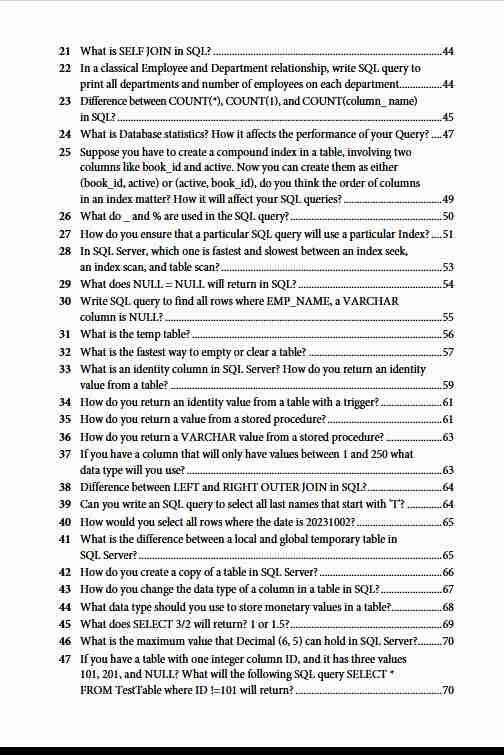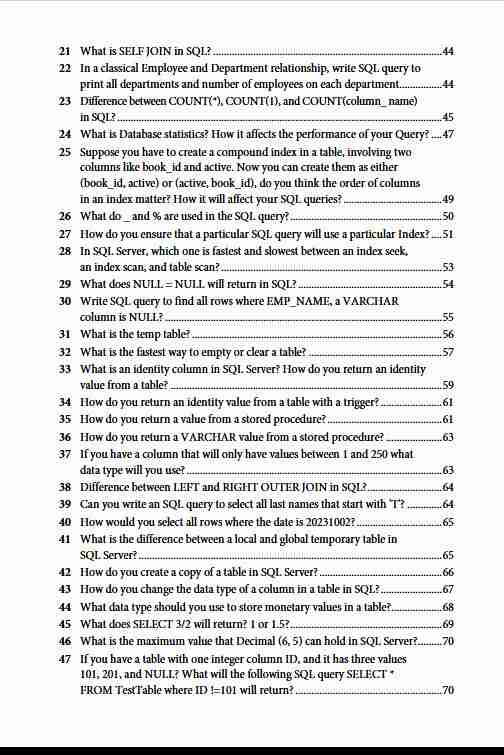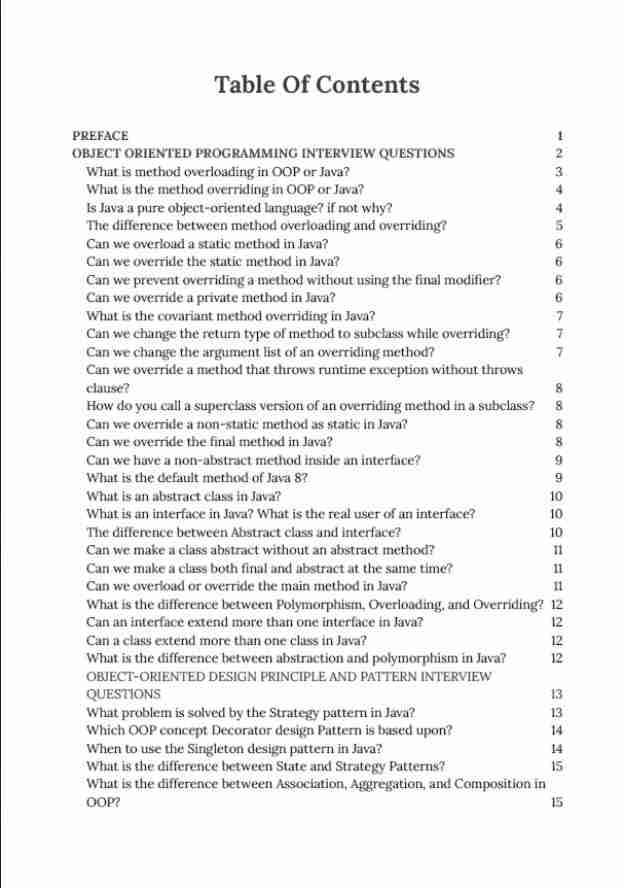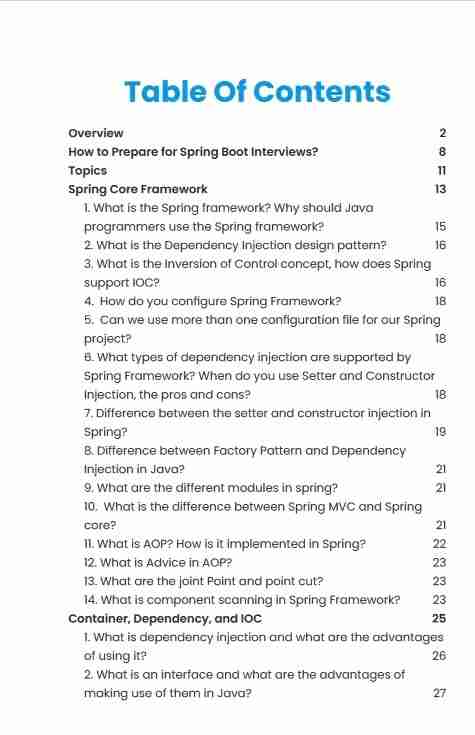연습용 Java 면접 질문 답변
Disclosure: This post includes affiliate links; I may receive compensation if you purchase products or services from the different links provided in this article.
_

Hello devs, are you preparing for Java developer interviews? If Yes, here is a list of some useful Java interview questions for experienced Java programmers having experience in range of 2 to 5 years.
As an experienced developer you are expected to learn about OOP concepts, Java basics, Java Collection framework, Multi-threading and Concurrency utilities introduced in Java 5 and 6, Debugging Java application, Algorithm and Data structure, Some questions on design patterns, JVM and Garbage collection and couple of puzzles.
Actually its mix of everything you do in your day to day work.
If you are going for Java developer with some exposure on web development you will also be asked about popular Java frameworks like Spring, Hibernate, Struts 2.0 and others.
If you have more than 5 years of experience you can also expect questions about build tools like Maven, ANT and Gradle, Java best practices, Unit testing and JUnit and your experience about solving production issues.
One of the most common question I have faced is talking about the last production problem you have faced and how did you solved it.
If you are asked same question, give them step by step detail, right from analyzing problem to tactical fix to strategic solution.
In this article, I am going to share my list of Java Interview question for Java guys having 2 to 5 years of experience. Since I had similar experience couple of year ago, I know what questions are asked and keeping a list for your own always helps when you start looking for new challenge in your career.
I am not providing answers of these question in this post due to two reasons, questions are quite simple and you guys probably know the answer, second providing answer means I cannot use this post for my own preparation later, which is more important.
Though, I could write another article answering all these question if anyone request or I feel people need it.
By the way, if you are new to Java programming language or want to improve Java skills then you can also checkout sites like CodeGym, ZTM and karpado to learn Java by building Games and projects.

Java Interview Questions for 1 to 2 years Experienced
This list contains questions from different topics e.g. OOP concepts, multi-threading and concurrency, Java collections, Web services, Spring, Hibernate, Database and JDBC, it doesn't cover all topics you need to prepare.
I will add few more topics later when I have some time, for now, try to answer these questions without doing Google :)
Java Interview questions on OOP Concepts
Here are a couple of questions on OOP design, SOLID principle and baseic programming concepts
1. What is the difference between loose coupling and tight coupling?
Loose coupling allows components to interact with each other with minimal dependencies, while tight coupling creates strong dependencies between components.
2. What is the difference between cohesion and coupling?
Cohesion refers to the degree to which elements within a module belong together, while coupling refers to the degree of interdependence between modules.
3. What is Liskov Substitution principle? Can you explain with an example?
Liskov Substitution principle states that objects of a superclass should be replaceable with objects of its subclasses without affecting the correctness of the program.
For example, if you have a class hierarchy with a superclass "Shape" and subclasses "Circle" and "Square", any method that works with Shape should also work with Circle or Square without causing errors.
4. What is the difference between abstract class and interface in Java?
Abstract classes can have both abstract and concrete methods, while interfaces can only have abstract methods. Additionally, a class can implement multiple interfaces but can only extend one abstract class.
5. What is the difference between composition, aggregation, and association?
Composition implies a strong ownership relationship where the lifetime of the contained object is dependent on the container.
Aggregation implies a weaker relationship where the contained object can exist independently of the container. Association implies a relationship between two classes without any ownership or lifecycle dependency.
Java Interview questions on Collections
Now, let's see a few questions form Collections and Stream
1. Difference between List, Set, and Map in Java?
Lists maintain elements in sequential order and allow duplicates (e.g., ArrayList, LinkedList). Sets do not allow duplicates and do not guarantee order (e.g., HashSet, TreeSet). Maps store key-value pairs and do not allow duplicate keys (e.g., HashMap, TreeMap).
2. Difference between synchronized and concurrent collection in Java?
Synchronized collections use explicit locking to achieve thread-safety, allowing only one thread to modify the collection at a time. Concurrent collections use non-blocking algorithms and are designed for high concurrency, allowing multiple threads to modify the collection concurrently without explicit locking.
3. How does the get method of HashMap work in Java?
The get method of HashMap calculates the hash code of the provided key, determines the index in the underlying array based on the hash code, and then searches for the key at that index. If found, it returns the corresponding value; otherwise, it returns null.
4. How is ConcurrentHashMap different from Hashtable? How does it achieve thread-safety?
ConcurrentHashMap allows concurrent access to the map without blocking, while Hashtable uses synchronized methods to achieve thread-safety, resulting in potential performance bottlenecks. ConcurrentHashMap achieves thread-safety by dividing the map into segments, each with its lock, allowing multiple threads to modify different segments concurrently.
5. When to use LinkedList over ArrayList in Java?
Use LinkedList when frequent insertion and deletion operations are required, as LinkedList provides constant-time insertion and deletion at any position. Use ArrayList when random access and iteration are frequent, as ArrayList provides constant-time access by index.
Java Interview questions on Concurrency and Threads
Now, its time to see questions from Java multithreading and concurrency concepts:
1. How do notify and notifyAll work, and what's the difference between them? Why prefer notifyAll to notify?
Both notify and notifyAll are methods in Java used to wake up threads waiting on a monitor (i.e., waiting to acquire an object's lock). notify wakes up one randomly selected thread, while notifyAll wakes up all waiting threads. notifyAll is preferred because it ensures that all waiting threads are notified, preventing potential indefinite waiting and improving system responsiveness.
2. What is a race condition and how do you avoid it?
A race condition occurs when the outcome of a program depends on the timing or interleaving of multiple threads. To avoid race conditions, you can use synchronization mechanisms like locks, semaphores, or atomic operations to ensure that critical sections of code are executed atomically or only by one thread at a time.
3. What is a deadlock and how do you avoid it?
Deadlock occurs when two or more threads are stuck waiting for each other to release resources that they need to proceed. To avoid deadlock, you can use techniques such as resource ordering, avoiding nested locks, or using timeouts for acquiring locks. Additionally, designing code with a clear and consistent locking order can help prevent deadlocks.
4. What are some of the high-level concurrency classes provided by java.util.concurrent and how do they work?
Some high-level concurrency classes provided by java.util.concurrent include ExecutorService, ThreadPoolExecutor, CountDownLatch, Semaphore, CyclicBarrier, BlockingQueue, and ConcurrentHashMap. These classes provide thread-safe implementations of common concurrency patterns and mechanisms like thread pools, synchronization primitives, and concurrent data structures.
5. Can you implement a producer-consumer solution in Java?
Yes, here is the code:
import java.util.concurrent.ArrayBlockingQueue;
class Producer implements Runnable {
private final ArrayBlockingQueue queue;
private int count = 0;
Producer(ArrayBlockingQueue queue) {
this.queue = queue;
}
public void run() {
try {
while (true) {
queue.put(produce());
Thread.sleep(1000); // Simulate some work
}
} catch (InterruptedException e) {
Thread.currentThread().interrupt();
}
}
private int produce() {
System.out.println("Producing: " count);
return count ;
}
}
class Consumer implements Runnable {
private final ArrayBlockingQueue queue;
Consumer(ArrayBlockingQueue queue) {
this.queue = queue;
}
public void run() {
try {
while (true) {
consume(queue.take());
}
} catch (InterruptedException e) {
Thread.currentThread().interrupt();
}
}
private void consume(int item) {
System.out.println("Consuming: " item);
}
}
public class Main {
public static void main(String[] args) {
ArrayBlockingQueue queue = new ArrayBlockingQueue(10);
Producer producer = new Producer(queue);
Consumer consumer = new Consumer(queue);
Thread producerThread = new Thread(producer);
Thread consumerThread = new Thread(consumer);
producerThread.start();
consumerThread.start();
}
}
Java Interview questions on Database, SQL, and JDBC
JDBC is used for connecting database from Java program, let's ee a few questions on Database and JDBC
1. How do you prevent SQL injection attacks?
To prevent SQL injection attacks, use parameterized queries (prepared statements) with bound parameters, input validation, and escape characters. Avoid dynamic SQL queries constructed by concatenating user input.
2. What is the difference between WHERE and HAVING clause?
The WHERE clause filters rows before the grouping and aggregation process, while the HAVING clause filters aggregated data after the grouping process based on specified conditions.
3. What are transactions? What is ACID?
Transactions are a set of SQL statements that are executed as a single unit of work. ACID is an acronym for Atomicity, Consistency, Isolation, and Durability, which are properties that ensure the reliability of transactions in a database system.
4. Difference between truncate, delete, and drop clause in SQL?
- TRUNCATE: Removes all rows from a table but retains the table structure and any associated constraints or indexes.
- DELETE: Removes specific rows from a table based on a condition, but retains the table structure and associated constraints.
- DROP: Deletes an entire table, including its structure, data, and associated constraints and indexes.
5. What are window functions? How do they work?
Window functions perform calculations across a set of rows related to the current row within a query result set. They allow you to perform aggregate functions (such as SUM, AVG, COUNT) over a specified window or subset of rows, defined by the OVER clause. Window functions operate on a set of rows and return a single value for each row based on that set of rows. They are often used for tasks such as ranking, aggregation, and calculating running totals.
See, Grokking the SQL Interview book if you need more questions on Database and SQL

Java Interview questions on Hibernate
Now, its time to see questions from Hibernate, one of the popular Java framework:
1. When is it better to use plain SQL instead of ORM?
It's better to use plain SQL when:
- Complex queries need to be optimized for performance.
- The database schema or query requirements are not well-supported by the ORM framework.
- Direct control over SQL statements, database connections, or transactions is required.
2. Difference between sorted and ordered collection?
In Java, a sorted collection maintains elements in a specific order defined by a comparator or by the natural ordering of elements, while an ordered collection maintains elements in the order they were inserted.
3. How does second level cache work?
Second level cache in Hibernate stores objects in a shared cache region, typically across multiple sessions. When an entity is queried for the first time, it is fetched from the database and stored in the second level cache. Subsequent queries for the same entity can then be satisfied from the cache instead of hitting the database, improving performance.
4. What is the difference between save() and persist() in Hibernate?
Both save() and persist() methods in Hibernate are used to save an entity to the database. However, save() returns the generated identifier immediately, while persist() doesn't guarantee immediate execution of the SQL INSERT statement; it may be executed later during flush time. Additionally, persist() is part of the JPA specification, while save() is specific to Hibernate.
5. What is the difference between Hibernate and MyBatis?
- Hibernate is a full-fledged ORM framework that maps Java objects to database tables, manages database connections, and provides various querying mechanisms. MyBatis, on the other hand, is a lightweight persistence framework that uses SQL mapping files to map Java objects to SQL queries.
- Hibernate is typically used for domain-driven development, where object-oriented modeling is prominent, while MyBatis is often preferred for projects where direct control over SQL queries is required, such as legacy database systems or complex SQL scenarios.
- Hibernate provides caching mechanisms, automatic dirty checking, and transaction management, while MyBatis offers more control over SQL queries and mappings, allowing developers to write SQL queries directly.
Java Interview questions on Web Services and Microservices
Now, let's see questions form Microservice architecture and REST web services
1. Difference between SOAP-based and REST-based web services?
SOAP is protocol-based with rigid structure, while REST is architectural style based on stateless communication with flexible endpoints.
2. What is SOAP Envelope?
It encapsulates the entire SOAP message and defines its structure.
3. How to implement security in RESTful web service?
Implement SSL/TLS for encryption and authentication.
4. What is Payload in REST?
It's the data transmitted in the body of the HTTP request or response.
5. What is Microservices?
It's an architectural style where applications are composed of small, independent services.
6. What is the difference between Microservices and REST?
Microservices refer to architectural design, while REST is an architectural style for networked applications.
7. What is the difference between Monolithic and Microservices?
Monolithic has single codebase, while Microservices have multiple, independent components; Monolithic can have higher latency.
8. What problem does SAGA pattern solve?
It manages distributed transactions in Microservices architecture.
9. What is service discovery in Microservices?
It's the mechanism for locating services dynamically within a Microservices architecture.
- What are common Microservices Patterns you have used in your project? Service Registry, Circuit Breaker, API Gateway.
Java and Spring Interview Preparation Material
Before any Java and Spring Developer interview, I always read the Grokking the Java Interview and Grokking the Spring boot Interviw
Here are few more questions from these books:

and,

And, if you are new to Java then you can also checkout sites like CodeGym, ZTM and karpado to learn Java by building Games and projects.
Thank you guys for now. You can find the answers in web easily but if there are enough interest, I can also update the post. Let me know if you have also asked these questions before. If anyone knows answer, can also post as comment.
Good luck for your Java Interview.
By the way, if you are new to Java programming language or want to improve Java skills then you can also checkout following best Java courses to get better:
-
 McRypt에서 OpenSSL로 암호화를 마이그레이션하고 OpenSSL을 사용하여 McRypt 암호화 데이터를 해제 할 수 있습니까?질문 : McRypt에서 OpenSSL로 내 암호화 라이브러리를 업그레이드 할 수 있습니까? 그렇다면 어떻게? 대답 : 대답 : 예, McRypt에서 암호화 라이브러리를 OpenSSL로 업그레이드 할 수 있습니다. OpenSSL을 사용하여 McRyp...프로그램 작성 2025-04-17에 게시되었습니다
McRypt에서 OpenSSL로 암호화를 마이그레이션하고 OpenSSL을 사용하여 McRypt 암호화 데이터를 해제 할 수 있습니까?질문 : McRypt에서 OpenSSL로 내 암호화 라이브러리를 업그레이드 할 수 있습니까? 그렇다면 어떻게? 대답 : 대답 : 예, McRypt에서 암호화 라이브러리를 OpenSSL로 업그레이드 할 수 있습니다. OpenSSL을 사용하여 McRyp...프로그램 작성 2025-04-17에 게시되었습니다 -
 열의 열이 다른 데이터베이스 테이블을 어떻게 통합하려면 어떻게해야합니까?다른 열이있는 결합 테이블 ] 는 데이터베이스 테이블을 다른 열로 병합하려고 할 때 도전에 직면 할 수 있습니다. 간단한 방법은 열이 적은 테이블의 누락 된 열에 null 값을 추가하는 것입니다. 예를 들어, 표 B보다 더 많은 열이있는 두 개의 테이블,...프로그램 작성 2025-04-17에 게시되었습니다
열의 열이 다른 데이터베이스 테이블을 어떻게 통합하려면 어떻게해야합니까?다른 열이있는 결합 테이블 ] 는 데이터베이스 테이블을 다른 열로 병합하려고 할 때 도전에 직면 할 수 있습니다. 간단한 방법은 열이 적은 테이블의 누락 된 열에 null 값을 추가하는 것입니다. 예를 들어, 표 B보다 더 많은 열이있는 두 개의 테이블,...프로그램 작성 2025-04-17에 게시되었습니다 -
 두 날짜 사이의 일 수를 계산하는 JavaScript 방법const date1 = 새로운 날짜 ( '7/13/2010'); const date2 = new 날짜 ('12/15/2010 '); const difftime = math.abs (date2 -date1); const diff...프로그램 작성 2025-04-17에 게시되었습니다
두 날짜 사이의 일 수를 계산하는 JavaScript 방법const date1 = 새로운 날짜 ( '7/13/2010'); const date2 = new 날짜 ('12/15/2010 '); const difftime = math.abs (date2 -date1); const diff...프로그램 작성 2025-04-17에 게시되었습니다 -
 자바 스크립트 객체의 키를 알파벳순으로 정렬하는 방법은 무엇입니까?object.keys (...) . .sort () . 정렬 된 속성을 보유 할 새 개체를 만듭니다. 정렬 된 키 어레이를 반복하고 리소셔 함수를 사용하여 원래 객체에서 새 객체에 해당 값과 함께 각 키를 추가합니다. 다음 코드는 프로세...프로그램 작성 2025-04-17에 게시되었습니다
자바 스크립트 객체의 키를 알파벳순으로 정렬하는 방법은 무엇입니까?object.keys (...) . .sort () . 정렬 된 속성을 보유 할 새 개체를 만듭니다. 정렬 된 키 어레이를 반복하고 리소셔 함수를 사용하여 원래 객체에서 새 객체에 해당 값과 함께 각 키를 추가합니다. 다음 코드는 프로세...프로그램 작성 2025-04-17에 게시되었습니다 -
 PHP 배열 키-값 이상 : 07 및 08의 호기심 사례 이해이 문제는 PHP의 주요 0에 대한 해석에서 비롯됩니다. 숫자가 0 (예 : 07 또는 08)으로 접두사를 넣으면 PHP는 소수점 값이 아닌 옥탈 값 (기본 8)으로 해석합니다. 설명 : echo 07; // 인쇄 7 (10 월 07 = 10 진수 7...프로그램 작성 2025-04-17에 게시되었습니다
PHP 배열 키-값 이상 : 07 및 08의 호기심 사례 이해이 문제는 PHP의 주요 0에 대한 해석에서 비롯됩니다. 숫자가 0 (예 : 07 또는 08)으로 접두사를 넣으면 PHP는 소수점 값이 아닌 옥탈 값 (기본 8)으로 해석합니다. 설명 : echo 07; // 인쇄 7 (10 월 07 = 10 진수 7...프로그램 작성 2025-04-17에 게시되었습니다 -
 Visual Studio 2012의 DataSource 대화 상자에 MySQL 데이터베이스를 추가하는 방법은 무엇입니까?MySQL 커넥터 v.6.5.4가 설치되어 있지만 Entity 프레임 워크의 DataSource 대화 상자에 MySQL 데이터베이스를 추가 할 수 없습니다. 이를 해결하기 위해 MySQL 용 공식 Visual Studio 2012 통합은 MySQL 커넥터 v.6....프로그램 작성 2025-04-17에 게시되었습니다
Visual Studio 2012의 DataSource 대화 상자에 MySQL 데이터베이스를 추가하는 방법은 무엇입니까?MySQL 커넥터 v.6.5.4가 설치되어 있지만 Entity 프레임 워크의 DataSource 대화 상자에 MySQL 데이터베이스를 추가 할 수 없습니다. 이를 해결하기 위해 MySQL 용 공식 Visual Studio 2012 통합은 MySQL 커넥터 v.6....프로그램 작성 2025-04-17에 게시되었습니다 -
 Java는 여러 반환 유형을 허용합니까 : 일반적인 방법을 자세히 살펴보십시오.public 목록 getResult (문자열 s); 여기서 foo는 사용자 정의 클래스입니다. 이 방법 선언은 두 가지 반환 유형을 자랑하는 것처럼 보입니다. 목록과 E. 그러나 이것이 사실인가? 일반 방법 : 미스터리 메소드는 단일...프로그램 작성 2025-04-17에 게시되었습니다
Java는 여러 반환 유형을 허용합니까 : 일반적인 방법을 자세히 살펴보십시오.public 목록 getResult (문자열 s); 여기서 foo는 사용자 정의 클래스입니다. 이 방법 선언은 두 가지 반환 유형을 자랑하는 것처럼 보입니다. 목록과 E. 그러나 이것이 사실인가? 일반 방법 : 미스터리 메소드는 단일...프로그램 작성 2025-04-17에 게시되었습니다 -
 오른쪽에서 CSS 배경 이미지를 찾는 방법은 무엇입니까?/ 오른쪽에서 10px 요소를 배치하려면 / 배경 위치 : 오른쪽 10px 상단; 이 CSS 상단 코너는 오른쪽 상단의 왼쪽에서 10 pixels가되어야합니다. 요소의 상단 에지. 이 기능은 Internet Explorer 8 또는 이...프로그램 작성 2025-04-17에 게시되었습니다
오른쪽에서 CSS 배경 이미지를 찾는 방법은 무엇입니까?/ 오른쪽에서 10px 요소를 배치하려면 / 배경 위치 : 오른쪽 10px 상단; 이 CSS 상단 코너는 오른쪽 상단의 왼쪽에서 10 pixels가되어야합니다. 요소의 상단 에지. 이 기능은 Internet Explorer 8 또는 이...프로그램 작성 2025-04-17에 게시되었습니다 -
 Fastapi Custom 404 페이지 제작 가이드custom 404 fastapi 가없는 페이지를 찾을 수 없습니다. 적절한 방법은 특정 요구 사항에 따라 다릅니다. 404 상태 코드에서 리디렉션 response = await call_next(request) if response.sta...프로그램 작성 2025-04-17에 게시되었습니다
Fastapi Custom 404 페이지 제작 가이드custom 404 fastapi 가없는 페이지를 찾을 수 없습니다. 적절한 방법은 특정 요구 사항에 따라 다릅니다. 404 상태 코드에서 리디렉션 response = await call_next(request) if response.sta...프로그램 작성 2025-04-17에 게시되었습니다 -
 Google API에서 최신 JQuery 라이브러리를 검색하는 방법은 무엇입니까?https://code.jquery.com/jquery-latest.min.js (jQuery Hosted, Minified) https://code.jquery.com/jquery-latest.js (JQuery Hosted, Hosted, 비 압축) 압축...프로그램 작성 2025-04-17에 게시되었습니다
Google API에서 최신 JQuery 라이브러리를 검색하는 방법은 무엇입니까?https://code.jquery.com/jquery-latest.min.js (jQuery Hosted, Minified) https://code.jquery.com/jquery-latest.js (JQuery Hosted, Hosted, 비 압축) 압축...프로그램 작성 2025-04-17에 게시되었습니다 -
 유효한 코드에도 불구하고 PHP의 입력을 캡처하는 사후 요청이없는 이유는 무엇입니까?post request 오작동 주소 php action='' action = "프로그램 작성 2025-04-17에 게시되었습니다
유효한 코드에도 불구하고 PHP의 입력을 캡처하는 사후 요청이없는 이유는 무엇입니까?post request 오작동 주소 php action='' action = "프로그램 작성 2025-04-17에 게시되었습니다 -
 끈적 끈적하고 전체 출혈 요소를 완벽하게 결합하는 팁最近我遇到一个独特的布局需求:在页面包含全屏元素的同时,保持一个元素始终固定在顶部。这实现起来相当棘手,因此我将记录下我的解决方案,以备不时之需。尤其是在小屏幕上的逻辑定位处理上,更是增加了难度。 效果难以用文字描述,所以我录制了屏幕视频来说明我的意思。请特别注意主要的号召性用语部分,也就是带有“...프로그램 작성 2025-04-17에 게시되었습니다
끈적 끈적하고 전체 출혈 요소를 완벽하게 결합하는 팁最近我遇到一个独特的布局需求:在页面包含全屏元素的同时,保持一个元素始终固定在顶部。这实现起来相当棘手,因此我将记录下我的解决方案,以备不时之需。尤其是在小屏幕上的逻辑定位处理上,更是增加了难度。 效果难以用文字描述,所以我录制了屏幕视频来说明我的意思。请特别注意主要的号召性用语部分,也就是带有“...프로그램 작성 2025-04-17에 게시되었습니다 -
 SQLALCHEMY 필터 조항에서 'Flake8'플래킹 부울 비교가 된 이유는 무엇입니까?제공된 예에서 데이터베이스 테이블의 부울 필드 (Obsoleted)는 비 공급 테스트 사례를 결정하는 데 사용됩니다. 이 코드는 필터 절에서 테스트 케이스를 사용합니다. casenum = session.query (testcase) .filter (testc...프로그램 작성 2025-04-17에 게시되었습니다
SQLALCHEMY 필터 조항에서 'Flake8'플래킹 부울 비교가 된 이유는 무엇입니까?제공된 예에서 데이터베이스 테이블의 부울 필드 (Obsoleted)는 비 공급 테스트 사례를 결정하는 데 사용됩니다. 이 코드는 필터 절에서 테스트 케이스를 사용합니다. casenum = session.query (testcase) .filter (testc...프로그램 작성 2025-04-17에 게시되었습니다 -
 PostgreSQL의 각 고유 식별자에 대한 마지막 행을 효율적으로 검색하는 방법은 무엇입니까?postgresql : 각각의 고유 식별자에 대한 마지막 행을 추출하는 select distinct on (id) id, date, another_info from the_table order by id, date desc; id ...프로그램 작성 2025-04-17에 게시되었습니다
PostgreSQL의 각 고유 식별자에 대한 마지막 행을 효율적으로 검색하는 방법은 무엇입니까?postgresql : 각각의 고유 식별자에 대한 마지막 행을 추출하는 select distinct on (id) id, date, another_info from the_table order by id, date desc; id ...프로그램 작성 2025-04-17에 게시되었습니다 -
 422 오류를 피하기 위해 JSON 데이터를 JavaScript에서 Fastapi로 보내는 방법은 무엇입니까?단일 바디 매개 변수가있는 경우 바디 유형의 Embed = True 인수를 사용하여 Code를 더 단순화 할 수 있습니다.이를 통해 Fastapi는 내장 된 본문에서 JSON 데이터를 직접 구문 분석 할 수 있습니다. JavaScript 클라이언트를 구성하여 ...프로그램 작성 2025-04-17에 게시되었습니다
422 오류를 피하기 위해 JSON 데이터를 JavaScript에서 Fastapi로 보내는 방법은 무엇입니까?단일 바디 매개 변수가있는 경우 바디 유형의 Embed = True 인수를 사용하여 Code를 더 단순화 할 수 있습니다.이를 통해 Fastapi는 내장 된 본문에서 JSON 데이터를 직접 구문 분석 할 수 있습니다. JavaScript 클라이언트를 구성하여 ...프로그램 작성 2025-04-17에 게시되었습니다
중국어 공부
- 1 "걷다"를 중국어로 어떻게 말하나요? 走路 중국어 발음, 走路 중국어 학습
- 2 "비행기를 타다"를 중국어로 어떻게 말하나요? 坐飞机 중국어 발음, 坐飞机 중국어 학습
- 3 "기차를 타다"를 중국어로 어떻게 말하나요? 坐火车 중국어 발음, 坐火车 중국어 학습
- 4 "버스를 타다"를 중국어로 어떻게 말하나요? 坐车 중국어 발음, 坐车 중국어 학습
- 5 운전을 중국어로 어떻게 말하나요? 开车 중국어 발음, 开车 중국어 학습
- 6 수영을 중국어로 뭐라고 하나요? 游泳 중국어 발음, 游泳 중국어 학습
- 7 자전거를 타다 중국어로 뭐라고 하나요? 骑自行车 중국어 발음, 骑自行车 중국어 학습
- 8 중국어로 안녕하세요를 어떻게 말해요? 你好중국어 발음, 你好중국어 학습
- 9 감사합니다를 중국어로 어떻게 말하나요? 谢谢중국어 발음, 谢谢중국어 학습
- 10 How to say goodbye in Chinese? 再见Chinese pronunciation, 再见Chinese learning

























